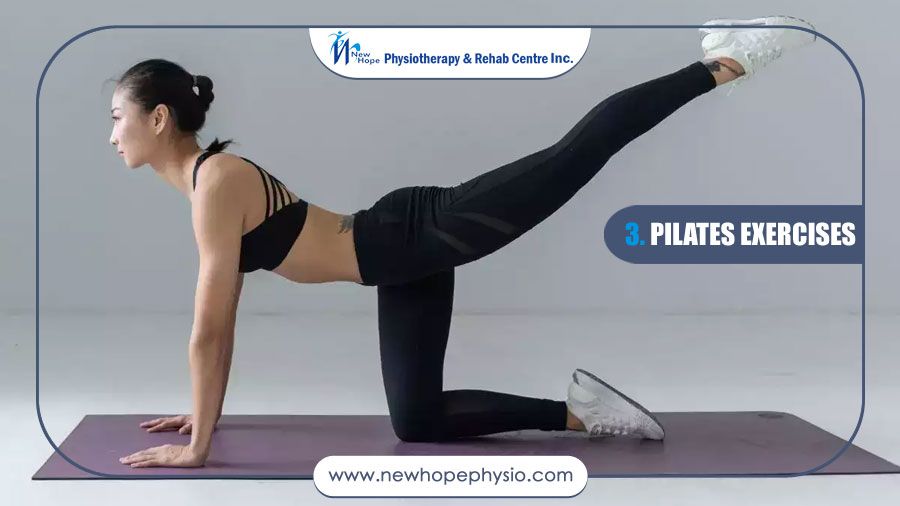Imagine this: you’re laughing with a friend, and suddenly, a little leak happens. Perhaps you’ve felt a pang of discomfort after a particularly strenuous workout. These experiences, while common, can be incredibly frustrating and embarrassing. The truth is, you’re not alone, and there’s a powerful solution: strengthening your pelvic floor muscles.

Image: www.melbourneosteohealth.com
The pelvic floor – a group of muscles that form a hammock-like structure supporting your bladder, uterus, and rectum – plays a crucial role in your physical health and overall well-being. From bladder control and sexual function to posture and core stability, a strong pelvic floor is essential. Pilates, with its focus on mindful movement and core engagement, offers a unique and effective approach to strengthening these vital muscles.
5 Pilates Exercises to Empower Your Pelvic Floor
Below, we delve into 5 essential Pilates exercises, each designed to target your pelvic floor muscles, offering a powerful pathway to enhanced control and support.
1. Kegel: A Foundation for Strength
The Kegel is a foundational exercise in pelvic floor strengthening. It’s surprisingly simple: imagine you’re trying to stop the flow of urine, contracting your pelvic floor muscles as if you’re lifting them upward and inward. Hold the contraction for 5-10 seconds, relax for a few seconds, and repeat 10-15 times.
Key Tips:
- Engage your pelvic floor without squeezing your glutes or thighs.
- Breathe deeply and evenly throughout the exercise.
- Practice Kegels throughout your day, incorporating them into your routine.
2. Bridge: Strengthening Core and Pelvic Floor Simultaneously
The Bridge exercise is a versatile and engaging way to build strength in both your core and pelvic floor muscles. Lie on your back with your knees bent and feet flat on the floor. Lift your hips off the floor, engaging your core and pelvic floor. Hold for a few seconds, then slowly lower back down.
Key Tips:
- Focus on lifting your hips with your pelvic floor muscles, as if you’re trying to draw your tailbone towards your heels.
- Maintain a neutral spine, ensuring your back isn’t overly arched.
- Aim for 10-15 repetitions, breathing smoothly throughout the movement.

Image: www.newhopephysio.com
3. Hundred: Breathing, Core, and Pelvic Floor Harmony
The Hundred, a Pilates classic, is a dynamic exercise that enhances your core strength while promoting mindful breathing. Lie on your back, bend your knees, and lift your head and shoulders slightly off the floor. Pump your arms up and down, inhaling for 5 counts and exhaling for 5 counts, while maintaining a gentle pelvic floor contraction.
Key Tips:
- Focus on engaging your pelvic floor muscles with each exhale, drawing them up and in.
- Maintain a consistent rhythm in your arm pumps, coordinating your breathing with the movement.
- Engage your abdominal muscles to support your core and spine.
4. Roll Down: Gentle Control and Pelvic Floor Engagement
The Roll Down, a slow and controlled movement, effectively strengthens your pelvic floor muscles while promoting flexibility. Sit upright with your legs extended. As you inhale, curl your spine forward, bringing your chest towards your knees. As you exhale, gently roll back up to a seated position, maintaining a slight pelvic floor contraction.
Key Tips:
- Focus on moving your spine segment by segment, starting at your tailbone.
- Don’t forget to engage your abdominal muscles to support your spine.
- Maintain a light pelvic floor contraction throughout the movement.
5. Single Leg Circle: Stability and Pelvic Floor Engagement
The Single Leg Circle, a challenging yet rewarding exercise, targets your pelvic floor muscles while enhancing core stability and hip mobility. Lie on your back with one leg extended and the other bent with your foot flat on the floor. Engage your pelvic floor muscles and carefully lift your extended leg off the floor. Draw small circles with your leg, clockwise and then counter-clockwise.
Key Tips:
- Focus on controlling the movement with your pelvic floor and core muscles.
- Maintain a steady breath throughout the circle movements.
- Start with smaller circles and gradually increase the range of motion as you strengthen.
Expert Insights: A Focus on Habit
Dr. Sarah Jones, a renowned pelvic floor physical therapist, emphasizes the importance of consistency in pelvic floor exercises. “Just like any muscle, the pelvic floor needs regular training to remain strong and functional,” Dr. Jones states. “Incorporate these exercises into your daily routine, and be sure to listen to your body, gradually increasing repetitions and complexity over time.”
5 Pilates Exercises For Pelvic Floor Muscles
A Call to Action: Embrace Your Strength
Embark on this journey to strengthen your pelvic floor. These Pilates exercises, when practiced consistently, can transform your well-being. From enhanced bladder control and improved sexual function to increased core stability and a boost in confidence, the benefits are immense.
Share your experience and connect with others on this path. Start today, and discover the empowerment that comes with a strong and healthy pelvic floor!
Note: While this article offers general information, it is crucial to consult with a qualified healthcare professional or certified Pilates instructor before beginning any new exercise program, particularly if you have any underlying health conditions.






